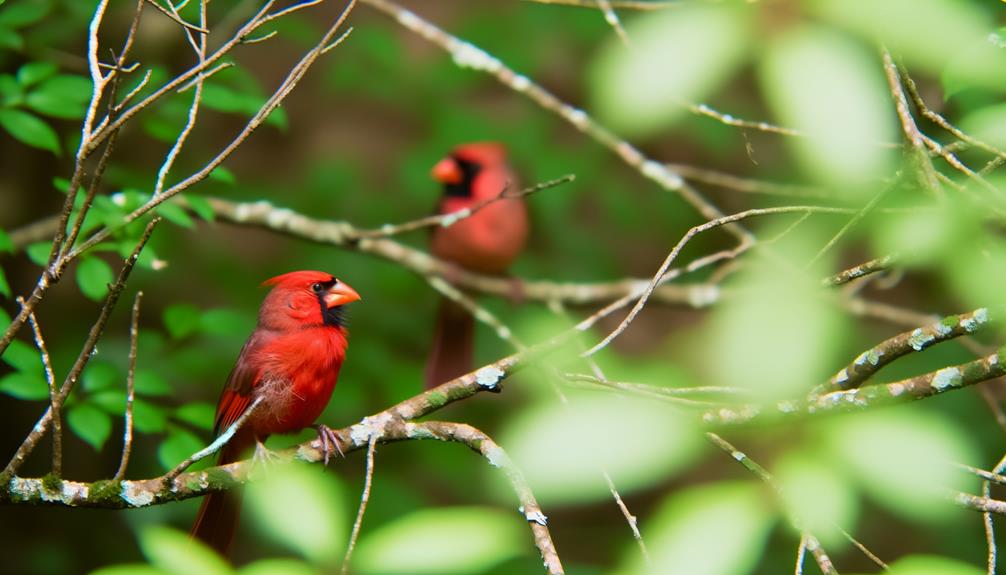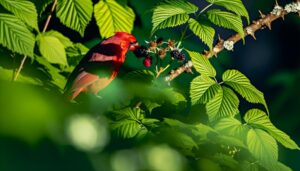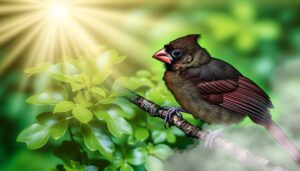Do Cardinals Have Black Beaks?
Cardinals do not have black beaks; their beak coloration typically ranges from bright orange to red. This vibrant hue is primarily due to carotenoid pigments obtained through their diet, including berries, seeds, and insects.
Male cardinals exhibit particularly bright beaks, while juvenile and female cardinals may have more subdued colors. Seasonal changes and hormonal fluctuations can also impact beak coloration.
The bright beak color serves as an indicator of good health and nutritional status, essential for mating and survival. There's more to discover about the fascinating adaptations of cardinal beak color.

Key Takeaways
- Juvenile cardinals may have dark, dusky beaks before maturing.
- Adult Northern Cardinals typically have bright orange-red beaks.
- Beak coloration in cardinals is influenced by diet and carotenoid intake.
- Seasonal and hormonal changes can affect beak hue, but not to black.
- Vermilion and other cardinal species also display vibrant beak colors, not black.
Cardinal Beak Colors

Cardinal beak colors vary significantly between species, with the Northern Cardinal (Cardinalis cardinalis) typically exhibiting a bright orange-red beak that contrasts starkly with its vibrant red plumage. This coloration is due to carotenoid pigments, which are ingested through the bird's diet and subsequently deposited in the beak.
Variations in diet can lead to slight color differences among individuals. Other cardinal species, such as the Vermilion Cardinal (Cardinalis phoeniceus), display similarly vivid beak colors, though the intensity and hue can differ. Juvenile cardinals generally possess more subdued beak colors, which intensify as they mature.
Understanding these color variations is essential for accurate species identification and can also provide insights into the bird's health and ecological interactions.
Male Cardinal Beaks
Male cardinals typically exhibit bright red-orange beaks, with variations influenced by genetic factors and environmental conditions.
Seasonal changes can also affect beak coloration, often correlating with breeding cycles and hormonal shifts.
Additionally, dietary intake, particularly the presence of carotenoids, plays an essential role in determining the vibrancy of the male cardinal's beak hue.
Beak Color Variations
Displaying a range of hues from bright orange to deep red, the beak color of male cardinals can vary noticeably due to factors such as diet, age, and genetics. This variability offers insights into the species' adaptability and health.
Carotenoids, pigments found in their diet, greatly influence beak coloration, while age can introduce changes in pigment deposition. Genetic factors also play an essential role, with certain alleles dictating the intensity and spectrum of colors observed.
- Diet: Carotenoid-rich foods enhance beak color intensity.
- Age: Younger males may exhibit duller beak hues compared to mature individuals.
- Genetics: Specific alleles determine color intensity and variation.
- Health: Vibrant beak color often indicates good health.
- Environmental Factors: Availability of pigment-rich food sources can cause regional differences.
Seasonal Color Changes
Throughout the year, the beak color of male cardinals undergoes subtle yet discernible alterations, influenced primarily by fluctuations in hormone levels and environmental conditions.
During the breeding season, increased testosterone levels result in a more vibrant red-orange hue, which serves as an indicator of health and cruciality to potential mates. Conversely, as the breeding season wanes and hormone levels stabilize, the beak color may shift to a slightly duller shade.
Additionally, environmental factors such as temperature and photoperiod (the length of day and night) also play a role in these seasonal changes. These biological and environmental influences guarantee that the male cardinal's beak color remains an effective tool for communication and survival throughout the year.
Diet and Beak Hue
The pigmentation of a male cardinal's beak is greatly influenced by its diet, particularly the intake of carotenoid-rich foods. Carotenoids are pigments found in various fruits and seeds that contribute to the vibrant coloration of the beak.
The metabolic assimilation of these pigments directly affects the hue, with higher concentrations resulting in brighter, more intense coloration. Therefore, the diet's nutritional quality is essential in maintaining the characteristic orange-red beak of a male cardinal.
Carotenoid sources include berries, seeds, and insects. The impact on pigmentation is significant, as enhanced coloration is observed with a higher intake of carotenoids. This not only affects the appearance of the bird but also serves as an indicator of its health and well-being.
Seasonal variation plays a role in the bird's diet, as changes can alter the beak hue seasonally. Brighter beaks may have mating implications, potentially attracting more mates. Understanding these dietary influences is important for comprehending the relationship between nutrition and beak coloration in cardinals.
Female Cardinal Beaks

Female cardinals exhibit distinct beak coloration compared to their male counterparts, typically featuring a more subdued hue. This color variation can be attributed to differing levels of carotenoid pigments, which play a role in their overall health and mating success.
Additionally, female cardinal beaks may undergo seasonal changes, influenced by hormonal shifts and environmental factors.
Color Differences Explained
Although both male and female cardinals share the characteristic of having bright orange beaks, subtle differences in hue and intensity can be observed between the sexes, particularly in females. Female cardinals tend to exhibit a slightly duller and less intense orange coloration compared to their male counterparts. This variation can be attributed to differences in hormonal levels, diet, and overall health.
Observations reveal that:
- Female beaks often appear more muted and less vibrant.
- The intensity of the orange can vary with age and environmental factors.
- Diet rich in carotenoids can enhance beak coloration.
- Hormonal fluctuations may influence the saturation of the beak color.
- Health and stress levels can impact the brightness and hue of the beak.
Understanding these nuances helps in accurate identification and appreciation of cardinal species.
Seasonal Beak Changes
Seasonal variations in environmental conditions can greatly influence the coloration of female cardinal beaks, adding another layer of complexity to their identification. During breeding seasons, hormonal changes can lead to a brighter orange beak, while non-breeding seasons often result in a duller, more muted color. This dynamic nature of beak pigmentation is not solely governed by internal factors but is also influenced by diet and overall health.
| Season | Beak Coloration |
|---|---|
| Spring | Bright Orange |
| Summer | Vivid Orange |
| Fall | Muted Orange |
| Winter | Dull Orange |
| Breeding Period | Brighter Orange |
Understanding these seasonal patterns helps ornithologists and bird enthusiasts accurately identify and study female cardinals, contributing to more effective conservation efforts.
Juvenile Cardinal Beaks
Juvenile cardinals typically exhibit beaks that range in color from dusky gray to black, gradually shifting to the characteristic bright orange-red as they mature. This color transformation is primarily influenced by the bird's diet and age.
The beak coloration in juveniles serves as an essential indicator of their developmental stage and overall health.
- Color Shift: Juvenile beaks start dusky gray, progressing to a deeper hue before turning orange-red.
- Diet Impact: Nutrient intake, particularly carotenoids, plays a critical role in beak pigmentation.
- Age Element: Beak color changes notably within the first year of life.
- Health Marker: Beak color can reflect nutritional status and health.
- Genetic Elements: Genetic predisposition also affects the rate and extent of color change.
This detailed understanding assists ornithologists in monitoring cardinal development.
Seasonal Variations

Seasonal variations in the beak coloration of cardinals are influenced by several factors. These factors include winter color changes, breeding season traits, and molting period variations. During the winter months, cardinals may exhibit a darker beak hue, potentially as an adaptive response to environmental conditions.
Conversely, the breeding season and molting periods bring distinct alterations in beak color. These changes reflect underlying physiological and hormonal changes.
Winter Color Changes
During winter, the plumage of cardinals often appears more vibrant, a phenomenon attributed to the best contrast against the snow-covered environment.
This enhanced coloration is not due to a change in the feathers themselves but rather the interplay of light and the reflective properties of the snow.
The following points outline key factors influencing this seasonal variation:
- Light Reflection: Snow reflects light, enhancing the perceived brightness of the cardinal's plumage.
- Dietary Factors: Winter diets rich in carotenoids can intensify feather pigmentation.
- Molt Patterns: Molting can lead to fresher, more vividly colored feathers.
- Environmental Contrast: The stark white of snow heightens the visual impact of the cardinal's red feathers.
- Survival Mechanism: Bright plumage may play a role in social signaling and mate attraction.
Breeding Season Traits
The breeding season of cardinals is marked by distinct changes in behavior and physical characteristics, which are vital for reproduction and survival.
During this period, male cardinals exhibit intensified red plumage, a signal of fitness to potential mates. This vibrant coloration is linked to higher testosterone levels and increased carotenoid intake. Behavioral adaptations include heightened territorial aggression and elaborate courtship displays, such as song and feeding rituals.
Female cardinals also undergo subtle changes; their beaks may appear darker due to hormonal shifts facilitating nesting and egg-laying. Both sexes engage in nest-building activities, selecting sites that provide best protection and resources.
These seasonal variations in traits are essential for successful mating and ensuring the continuation of the species.
Molting Period Variations
Molting in cardinals, a significant physiological process, involves the systematic shedding and regrowth of feathers, which varies substantially with seasonal changes. This phenomenon is essential for maintaining ideal feather condition, aiding in thermoregulation, and ensuring effective flight. The molting period is typically observed post-breeding season, aligning with late summer and early fall.
These seasonal variations can be influenced by several factors:
- Photoperiod: Length of daylight affects hormonal changes triggering molting.
- Nutrition: Availability of essential nutrients can accelerate or delay molting.
- Climate: Temperature and humidity play roles in molting efficiency.
- Age: Juvenile cardinals may have different molting cycles compared to adults.
- Geographical Location: Cardinals in different regions may experience varied molting periods.
Understanding these factors is essential for comprehending the molting dynamics in cardinals.
Diet and Beak Color
Cardinal beak color can be influenced by their diet, which is rich in carotenoid pigments found in various seeds, fruits, and insects. Carotenoids are organic pigments that cardinals cannot synthesize endogenously and must obtain through their food intake. These pigments are responsible for the red, orange, and yellow hues in their beaks.
A diet high in carotenoids results in a brighter and more vibrant beak coloration. Conversely, a deficiency in these pigments can lead to a duller beak appearance. The bioavailability of carotenoids in their diet, as well as the bird's ability to metabolize these pigments, directly affects the intensity of the beak color, illustrating the intricate relationship between diet and physical attributes in cardinals.
Health Indicators

Bright beak coloration in cardinals can serve as a reliable health indicator, reflecting the bird's nutritional status and overall well-being. The intensity and vibrancy of the beak color are influenced by the availability of carotenoids in the diet, which are essential pigments for pigmentation.
Healthy cardinals typically exhibit bright red or orange beaks, signifying good health and access to a rich diet. In contrast, dull or discolored beaks may indicate malnutrition or underlying health issues.
- Carotenoid intake: Essential for bright beak coloration.
- Hydration levels: Adequate water intake supports overall health.
- Parasite load: Lower parasite loads often correlate with brighter beaks.
- Genetic factors: Can influence beak pigmentation potential.
- Environmental stressors: Reduced stress enhances color vibrancy.
Understanding these factors helps in evaluating cardinal health.
Color Changes Over Time
As cardinals age, the color of their beaks can undergo noticeable changes, influenced by various biological and environmental factors. Juvenile cardinals typically have dark, almost black beaks, which gradually lighten as they mature. The shift in beak coloration is often linked to hormonal changes, dietary intake, and overall health status. Carotenoids, pigments found in their diet, play a pivotal role in this transformation, contributing to the development of a bright orange-red beak in adult cardinals.
| Age Stage | Beak Color | Influencing Factors |
|---|---|---|
| Juvenile | Dark/Black | Hormonal changes |
| Sub-adult | Darkening orange | Dietary intake |
| Adult | Bright orange-red | Carotenoid levels |
| Elderly | Dull orange | Health status and diet |
| Moulting phase | Variable | Seasonal changes |
Understanding these changes provides insight into the cardinal's life cycle and overall well-being.
Myths and Misconceptions

Numerous myths and misconceptions surround the coloration of cardinal beaks, often stemming from a lack of understanding of the bird's biological and environmental influences. One common misconception is that all cardinal beaks are black, when in fact, the typical adult cardinal beak is orange-red. Additionally, various factors can affect beak color, leading to occasional variations.
Key misconceptions include:
- Juvenile beaks: Believing young cardinals have the same beak color as adults.
- Dietary influences: Underestimating how diet impacts beak pigmentation.
- Sexual dimorphism: Assuming no color differences exist between male and female beaks.
- Seasonal changes: Misinterpreting seasonal color changes as permanent.
- Geographical variations: Overlooking regional differences in cardinal populations.
Understanding these nuances helps clarify the true nature of cardinal beak coloration.
Observing Cardinals
When observing cardinals, it is essential to note their distinct behaviors, habitats, and physical characteristics to accurately identify and study these vibrant birds. Cardinals are non-migratory and typically inhabit wooded areas, gardens, and shrublands. They exhibit a pronounced sexual dimorphism; males boast bright red plumage, while females display a more subdued brownish hue with red accents. Both genders feature a distinctive crest and a stout, conical beak, which is red-orange rather than black.
Behaviorally, cardinals are known for their territoriality, especially during breeding seasons. Their diet consists primarily of seeds, fruits, and insects, which they forage both on the ground and in bushes. Vocalizations are also a key identifier, with complex songs varying between individuals and regions.
Conclusion
To sum up, the beak coloration of cardinals is a complex topic influenced by sex, age, and health. Males usually show bright orange-red beaks, while females exhibit more muted tones. Juvenile beaks shift from dark to adult coloration as they grow.
Seasonal fluctuations may happen, but notable alterations often point to health concerns. Disproving misconceptions and grasping these subtleties enhances ornithological understanding. Studying these bird species is like unraveling a biological Rosetta Stone, unveiling detailed ecological and physiological interactions.






